Description: This tree is 30-90' tall at maturity, forming one to several trunks and an irregular crown that is usually more wide than tall. When there is a single trunk on a tree, it is usually short and stout; when multiple trunks are present, they are more narrow and lean away from each other. The bark trunk of old trees is mostly gray to nearly black and coarsely textured; it is covered with deep curving furrows. For younger trees, the bark trunk is grayish brown with shallow furrows and flattened ridges. The bark trunk is often discolored by the presence of various lichens. Twigs are usually pale brown and smooth, while the stems of young shoots are light green and pubescent. Alternate leaves that are 3-5" long and 1/4–2/3" (6-16 mm.) across occur along the twigs and shoots. Leaf blades are linear-lanceolate in shape and finely serrated along their margins. Upper surfaces of the leaf blades are medium to dark green and hairless to nearly hairless, while their lower surfaces are more or less medium green, hairless to nearly hairless, and never whitenened.
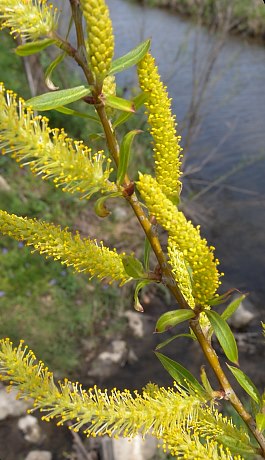
Petioles are very short (¼" or less in length), light green to cream-colored, and often short-pubescent. The auriculate-ovate (ovate with ear-like lobes) stipules at the bases of the petioles are either persistent or deciduous and about 1/8" (3 mm.) in length. Usually, on each tree, many leafy branches can be found with persistent stipules. Like other Salix spp., Black Willow is dioecious, producing either all male (staminate) or all female (pistillate) catkins on the same tree, but not both. The yellow to greenish white male catkins are 1-3" long, narrowly cylindrical in shape, and often curved; they are either ascending, widely spreading, or drooping. Each male catkin has numerous male florets that are arranged around its central axis in pseudo-whorls. Each male floret has 3-5 stamens; at its base, there is a small pubescent bract and a tiny gland. The bract is narrowly oval in shape and a little shorter than the stamens; its coloration is typically pale yellow. The greenish female catkins become longer as they mature; they are 1-3" in length, cylindrical in shape, and either ascending or widely spreading. Each female catkin has many female florets that are arranged around its central axis in pseudo-whorls. Each female floret consists of a glabrous pistil with a pair of short stigmata at its apex and a short pedicel underneath. The pistil is flask-shaped (lanceoloid) with a slender beak and 3-5 mm. in length (1/8" to nearly 1/4" in length).
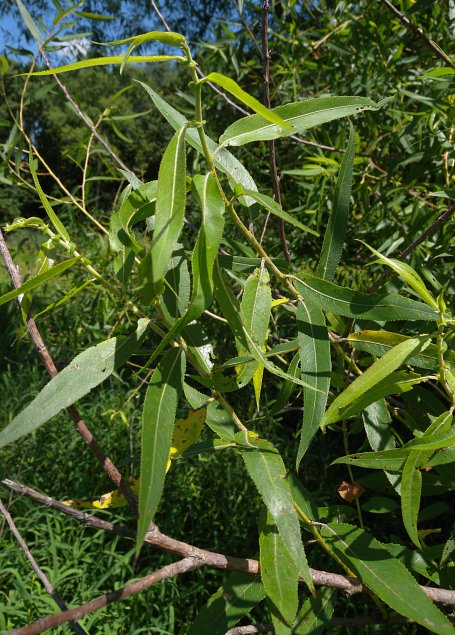
The blooming period occurs during mid-spring as the leaves begin to develop for about 1-2 weeks. The florets are pollinated by insects and possibly by wind. Male florets soon wither away, while female florets transform into seed capsules that split open to release the tiny hair-covered seeds. These seeds are distributed by both wind and water. The woody root system has widely spreading lateral roots. Black Willow can reproduce by seeds, or it can reproduce from broken branches that take root in moist soil. At favorable sites, colonies of this tree sometimes occur.
Cultivation: Black Willow prefers full or partial sun and wet to moist conditions. This tree adapts readily to a wide range of soil types, but it is more typical of heavy soil containing some clay or gravel, rather than sand. Black Willow grows rapidly, but it is rather short-lived. Because of its soft wood, this tree is prone to storm damage, and its widely spreading roots can clog water and sewer lines.
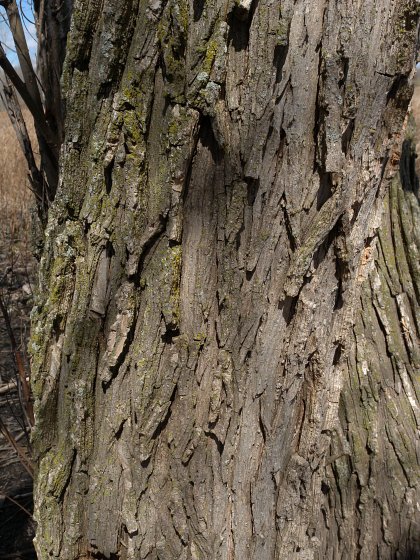
Range & Habitat: Black Willow is a common tree that is found in every county of Illinois (see Distribution Map), where it is native. Habitats include bottomland woodlands that are prone to regular flooding, swamps, riverbanks and low areas along rivers, borders of lakes, gravelly seeps, and seasonal wetlands that dry out during the summer. At some bottomland woodlands along major rivers, Black Willow is occasionally the dominant or codominant tree. Sometimes Black Willow is found along ditches, where it is often mowed over or cut down to the stump level. However, new shoots are likely to develop in response to such setbacks. Because of its widely spreading lateral roots, which help to bind the soil, this tree is sometimes deliberately planted along waterways that are vulnerable to erosion. In general, soggy disturbed areas are preferred where some sunlight is available.
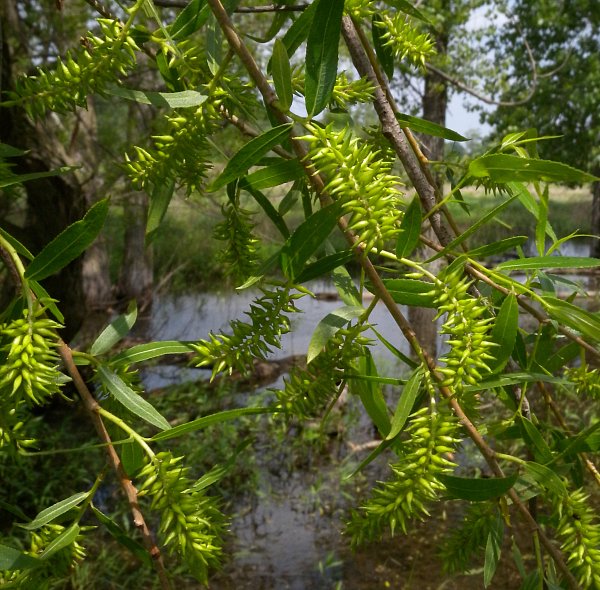
Faunal Associations: The nectar and pollen of Black Willow's flowers attract a variety of insects, especially bees and flies. These floral visitors include honeybees, bumblebees, little carpenter bees (Ceratina spp.), cuckoo bees (Nomada spp.), Halictid bees (including green metallic bees), Andrenid bees (Andrena spp.), march flies (Bibionidae), Syrphid flies, dance flies (Empididae), thick-headed flies (Conopidae), Tachinid flies, other flies, and various butterflies, wasps, and beetles (Robertson, 1929; Krombein et al., 1979). Some Andrenid bees are specialist pollinators of willows; they include Andrena andrenoides, Andrena bisalicis, Andrena erythrogaster, Andrena illinoiensis, Andrena nigrae, and Andrena salictaria. Other insects feed on the leaves, plant juices, catkins, wood, and other parts of willows (Salix spp.). These insect feeders include larvae of metallic wood-boring beetles, larvae of long-horned beetles, leaf beetles, weevils, larvae of leaf-mining flies, larvae of gall flies, plant bugs, stink bugs, aphids, spittlebugs, leafhoppers, armored scales, larvae of sawflies, larvae of moths, larvae of butterflies, and thrips (see Insect Table). Long-horned beetles, leaf beetles, plant bugs, aphids, sawflies, and especially moths are some of the more common kinds of insects that feed on willows. The leafhoppers Empoasca ellisae and Kybos nigra prefer Black Willow as a host plant, as do the larvae of a moth, the Darling Underwing (Catocala cara).
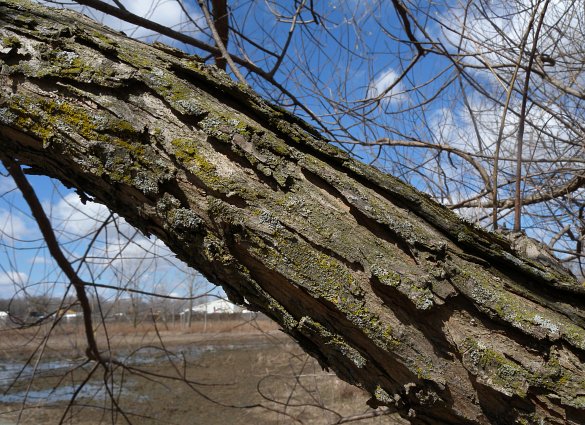
Among vertebrate animals, several kinds of birds use willows as a source of food (primarily buds & catkins), as well as a source of protective cover and nesting habitat. This includes such species as the Wood Duck, Mallard, Ruffed Grouse, Common Redpoll, Pine Grosbeak, White-crowned Sparrow, and Red-bellied Woodpecker. The Bird Table provides more information about these species. Mammals that use Black Willow and other willow species as a source of food include the American Beaver (wood, bark), American Moose and White-tailed Deer (twigs, foliage), Prairie Vole and Meadow Vole (catkins, foliage), Muskrat and Cottontail Rabbit (bark), Fox Squirrel (buds, catkins), and American Black Bear (buds, catkins, leaves). The Snapping Turtle (Chelydra serpentina) and Wood Turtle (Glyptemys insculpta) also consume the fallen leaves (Martin et al., 1951/1961; Hamerstrom & Blake, 1939; Romain et al., 2013; Ernst et al., 1994; Lagler, 1943). The American Beaver often uses the branches of willows in the construction of their dams and lodges.
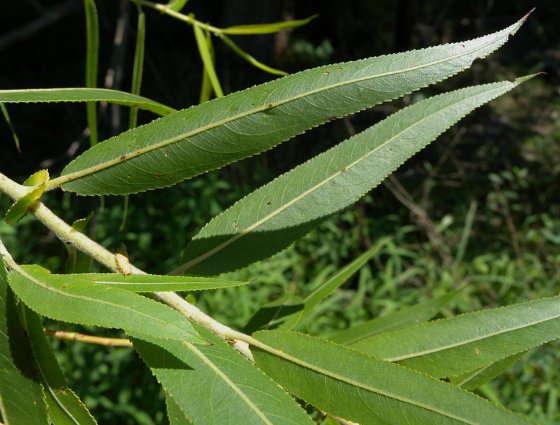
Photographic Location: A seasonal wetland at Judge Webber Park in Urbana, Illinois.
Comments: This is probably the largest native willow in Illinois that is most likely to develop into a full-sized tree. However, as a general rule, Black Willow (Salix nigra) develops a rather ragged and gnarled appearance by the time it becomes mature because of storm damage. The bark on its trunk and major branches adds to this appearance because of its coarse texture and shagginess. Black Willow can be distinguished from other similar willows by the undersides of its leaves – they are as green as their uppersides, rather than whitened. In addition, vigorous shoots of Black Willow have broad persistent stipules at the bases of the petioles of their leaves, while other similar willows, e.g., Peach-leaved Willow (Salix amygdaloides), have stipules that are more narrow and/or early-deciduous.